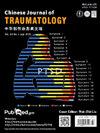基底池造口术治疗严重外伤性脑损伤:回顾性研究。
IF 1.9
4区 医学
Q2 ORTHOPEDICS
引用次数: 0
摘要
目的:创伤性脑损伤(TBI)是影响全世界个体的重大公共卫生问题,是导致死亡和发病的主要原因之一。通常的治疗方法是开颅减压术。基底脑池造口术已被证明是一种非常有效的替代手术,以减压颅骨切除术。方法:我们对2019年1月至2023年3月期间接受严重TBI手术的患者进行了回顾性队列研究。纳入标准是年龄在18岁至70岁之间,首次出现时符合严重TBI诊断标准并接受手术干预的患者。排除标准为入院时有严重多发伤的患者;术前颅内压> 60 mmHg;发病前的认知障碍;血液疾病;或心脏、肝脏、肾脏或其他内脏器官功能受损。根据手术入路的不同,将患者分为减压开颅组和基底池造口组。记录两组患者一般资料及术后指标,包括格拉斯哥昏迷评分、颅内压等。其中,6个月时的格拉斯哥结局量表扩展评估作为主要结局。之后,使用SPSS软件对数据进行统计分析。结果:该试验纳入41例患者(32男9女),符合纳入标准。其中25例行减压颅脑切除术,16例行基底池造口术。术后3 d颅内压分别为10.07±2.94 mmHg和17.15±14.65 mmHg (p = 0.013)。患者出院后6个月格拉斯哥预后量表延长值分别为4.73±2.28和3.14±2.15 (p = 0.027)。结论:我们的研究表明,基底池造瘘术在外科治疗的严重TBI患者中具有显著的降低颅内压和患者预后随访的效果,并且避免了骨瓣的切除。胆池造口术的疗效需要在更大的、多临床中心的随机试验中进行研究。本文章由计算机程序翻译,如有差异,请以英文原文为准。
The basal cisternostomy for management of severe traumatic brain injury: A retrospective study
Purpose
Traumatic brain injury (TBI) is a significant public health issue that impacts individuals all over the world and is one of the main causes of mortality and morbidity. Decompressive craniectomy is the usual course of treatment. Basal cisternostomy has been shown to be highly effective as an alternative procedure to decompressive craniectomy.
Methods
We conducted a retrospective cohort of patients who received surgery for severe TBI between January 2019 and March 2023. Inclusion criterias were patients between the ages of 18 and 70 years who met the diagnostic criteria for severe TBI at first presentation and who underwent surgical intervention. The exclusion criteria were patients who have severe multiple injuries at the time of admission; preoperative intracranial pressure > 60 mmHg; cognitive impairment before the onset of the disease; hematologic disorders; or impaired functioning of the heart, liver, kidneys, or other visceral organs. Depending on the surgical approach, the patients were categorized into decompressive craniectomy group as well as basal cisternostomy group. General data and postoperative indicators, including Glasgow coma scale, intracranial pressure, etc., were recorded for both groups of patients. Among them, the Glasgow outcome scale extended assessment at 6 months served as the primary outcome. After that, the data were statistically analyzed using SPSS software.
Results
The trial enrolled 41 patients (32 men and 9 women) who met the inclusion criteria. Among them, 25 patients received decompressive decompressive craniectomy, and 16 patients received basal cisternostomy. Three days postoperative intracranial pressure levels were 10.07 ± 2.94 mmHg and 17.15 ± 14.65 mmHg (p = 0.013), respectively. The 6 months following discharge Glasgow outcome scale extended of patients was 4.73 ± 2.28 and 3.14 ± 2.15 (p = 0.027), respectively.
Conclusion
Our study reveals that basal cisternostomy in patients with surgically treated severe TBI has demonstrated significant efficacy in reducing intracranial pressure as well as patient prognosis follow-up and avoids removal of the bone flap. The efficacy of cisternostomy has to be studied in larger, multi-clinical center randomized trials.
求助全文
通过发布文献求助,成功后即可免费获取论文全文。
去求助
来源期刊

Chinese Journal of Traumatology
ORTHOPEDICS-
CiteScore
3.80
自引率
4.80%
发文量
1707
审稿时长
28 weeks
期刊介绍:
Chinese Journal of Traumatology (CJT, ISSN 1008-1275) was launched in 1998 and is a peer-reviewed English journal authorized by Chinese Association of Trauma, Chinese Medical Association. It is multidisciplinary and designed to provide the most current and relevant information for both the clinical and basic research in the field of traumatic medicine. CJT primarily publishes expert forums, original papers, case reports and so on. Topics cover trauma system and management, surgical procedures, acute care, rehabilitation, post-traumatic complications, translational medicine, traffic medicine and other related areas. The journal especially emphasizes clinical application, technique, surgical video, guideline, recommendations for more effective surgical approaches.
 求助内容:
求助内容: 应助结果提醒方式:
应助结果提醒方式:


